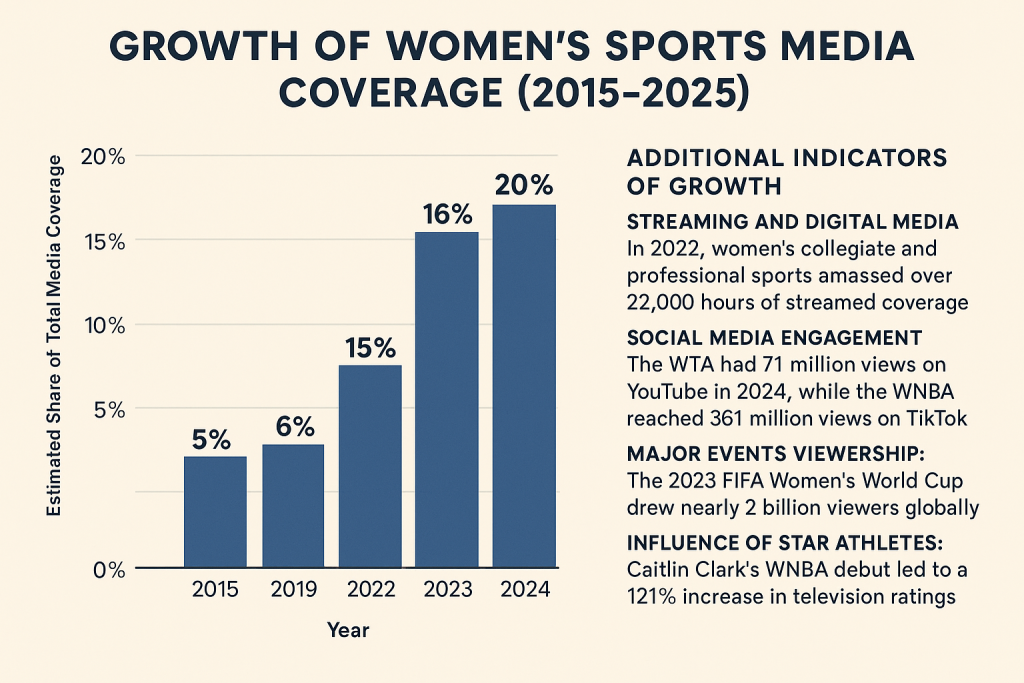
It is not necessarily when you arrive on the dance floor but how well you perform.
Let’s start with a question. For this question, you’ll get ten points.
Question: When was the first-ever media recording of women’s sports?
Answer: 2134–2000 BCE – Illustrations on Egyptian temple walls from the Eleventh Dynasty showed women exercising and playing ball games.
Right on the money! You get all ten points. If you want to trace the earliest recordings of women’s sports media, the illustrations on the Egyptian walls from the Eleventh Dynasty are where you should begin.

Let’s Build Our Case

If you ask any long-time supporter of women’s sports what the moment in modern history was that changed the coverage of the game and has been responsible for its consistent rise, and chatter around its value and equity, they won’t mention a specific tournament, game, or person. Even though they could, they won’t, because what truly changed the tide was a number. The number? 4%.
4% became symbolic because it represented a failure to acknowledge the work and impact of a large percentage of our society. However, it also represented a challenge and a sort of call to action: We can do better. And we have.
In the past few years, we’ve seen more journalists pivot to covering only women’s sports without the threat of being out of a job in two Sundays. We’ve seen new media emerge with the sole purpose of covering only women’s sports, and we’ve also seen legacy media try to do better. They’ve all been rewarded for their effort because—surprise, surprise—women’s sports happen all the time, so there is no short supply of content.
There have also been multiple TV deals, record-breaking viewership numbers, and massive fan engagement.
The revolution is truly being televised. What more shall we do?
Sustaining the Momentum
To maintain the growth in women’s sports, we need to always keep it on. It’s not enough to only cover the games during major tournaments, competitions, or finals. All levels and stages of the game need to be talked about and seen. This point also calls for creating different kinds of media. Realistically, we cannot expect all coverage from one source.
Women’s sports is not an appendage of men’s sports. We truly believe that women’s sports can stand on their own, it has and still is standing.
Conversations about it should not center on men’s sports. The growth and impact of men’s sports are important for our collective society and, in many ways, show what is possible through sheer human will and money. But it is not the standard for what women’s sports should be. There should not be an urgency to play catch-up that we skip pivotal aspects of growth and fail to build a sport for women, treating them as sub-men and then getting mad when it’s pointed out.
Creating Jobs & Preserving History
We need to create jobs. At every point of an industrial revolution, the workers made it happen. When there are no jobs, people leave, and when they leave, there is no growth. AI can be a tool but cannot replace live coverage, journalistic work, defining photography, or even designing the atmosphere for the fans. These are just a few things that require people.
Women’s sports are not inspirational porn. This has been said before, but we need to say it even more. They are, first and foremost, professional athletes before anything else. We understand the importance of their being an inspiration and do not negate the positive impact of increased coverage in encouraging a younger generation of women to be bold and take up space in sports from actively participating to building careers, from wanting to be athletes themselves to becoming coaches, executives, club owners, lawyers, historians, content creators, etc. We need everybody we can get for its sustained growth because that growth impacts not just women but society and global GDP.
Women’s sports are not a Ponzi scheme where you put money in and have to get it back quickly so it doesn’t crash while you’re still in. It’s been here since the first woman walked (because walking is a form of exercise), and it will continue to exist—not for lack of people trying.
When it comes to sponsorships and advertising, we should be ready to play the long game. It is an investment, and like all good investments, it gets better with time.
Before the current burst of media attention, many people worked hard behind the scenes to document the games and stories, preserving the history we have today of women’s sports media. Without their work, we would have nothing to reference. Without their work now, many important statistics and conversations would be lost, save for big moments with record-breaking numbers.
To understand how we need to grow, we must include these people in the conversations. Listen to them. Do not treat women’s sports as a cog in the wheel of making big bucks. We need to ensure that, at this point in women’s sports, we’re making the right decisions, the proper changes and with a long-term goal.